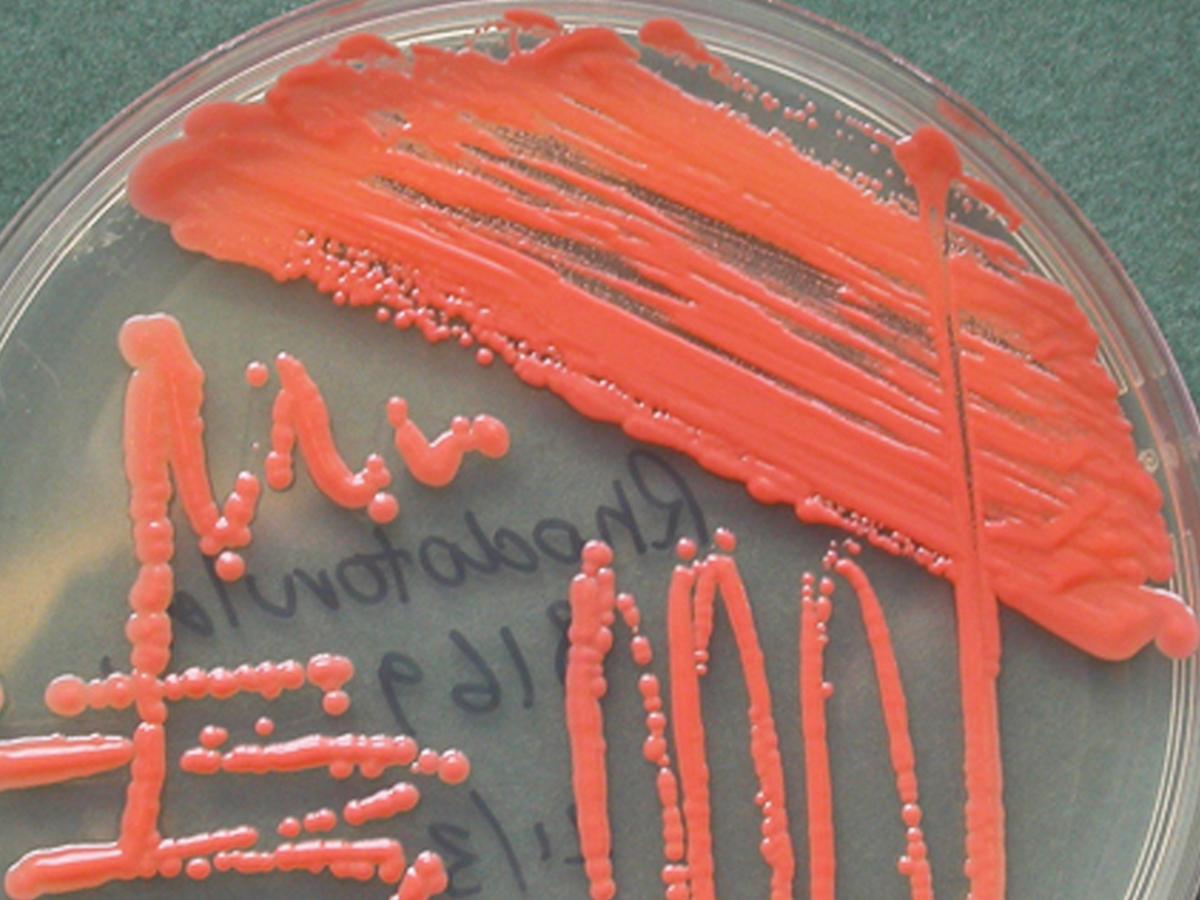Rhodotorula
Rhodotorula species are common environmental basidiomycetous yeasts, which can be found in soil, ocean and lake water, fruit juice and milk, and on shower curtains and toothbrushes.
Today, the genus contains 46 species of which three have been described as rare human pathogens: R. mucilaginosa (formerly known as R. rubra), R. glutinis and R. minuta (Arendrup et al. 2014).

Rhodotorula mucilaginosa culture.
Rhodotorula mucilaginosa is a common airborne contaminant of skin, lungs, urine and faeces. R. mucilaginosa is a known cause of fungal peritonitis in patients on continuous ambulatory peritoneal dialysis (CAPD). This is usually due to saprophytic colonisation of catheters or dialysis machinery and removal of the source of contamination usually leads to clearing of the symptoms. This species accounts for the majority of the infections (74–79%) followed by R. glutinis (7.7%) (Tuon and Costa 2008, Arendrup et al. 2014).
Molecular identification:
In many clinical cases species identification requires ITS and/or D1/D2 sequencing (Duboc de Almeida et al. 2008, Tuon and Costa 2008, Arendrup et al. 2014).
MALDI-TOF MS:
Reliably identifies clinically relevant Rhodotorula spp.
References:
McGinnis (1980), Barnett et al. (1983), Kreger-Van Rij (1984), Rippon (1988), Kurtzman and Fell (1988), de Hoog et al.(2000, 2015), Spiliopoulou et al. (2012), Duboc de Almeida et al. (2008), Tuon and Costa (2008), Arendrup et al. (2014).
Species descriptions
-
Rhodotorula glutinis
RG-1 organism.
Morphological description:
Colonies are coral red to salmon-coloured or slightly orange, smooth to wrinkled, highly glossy to semi-glossy. Mucoid to pasty to slightly tough, yeast-like colonies. Ovoidal to globose or more elongate budding yeast-like cells or blastoconidia, 2.3-5.0 x 4.0-10 µm.India ink preparation:
Small capsules present.Molecular identification:
Requires sequencing of the ITS and/or D1/D2 regions.Physiological Tests: + Positive, - Negative, v Variable, w Weak, s Slow, nd No Data Germ Tube - L-Sorbose v L-Arabinose v D-Glucitol v Fermentation Sucrose + D-Arabinose v 𝝰-M-D-Glucoside nd Glucose - Maltose + D-Ribose v D-Gluconate + Galactose - Cellobiose v L-Rhamnose v DL-Lactate v Sucrose - Trehalose + D-Glucosamime - myo-Inositol - Maltose - Lactose - N-A-D-glucosamine - 2-K-D-Gluconate nd Lactose - Melibiose - Glycerol v D-Glucuronate nd Trehalose - Raffinose v Erythritol - Nitrate - Assimilation Melezitose + Ribitol v Urease + Glucose + Soluble Starch - Galactitol v 0.1% Cycloheximide v Galactose v D-Xylose v D-Mannitol v Growth at 37C v Key features:
Germ tube negative yeast and sugar assimilation pattern. Common saprophyte however cases of fungaemia have been reported.Antifungal susceptibility: Rhodotorula glutinis (Diekema et al. 2005 and Australian national data); MIC µg/mL. Note: Rhodotorula species are intrinsically resistant to azoles and echinocandins (Arendrup et al. 2014).
Antifungal No ≤0.03 0.06 0.125 0.25 0.5 1 2 4 8 16 32 ≥64 AMB 38 1 2 4 3 28 FLU 38 38 VORI 36 1 1 12 12 9 1 POSA 34 2 9 18 4 1 ITRA 38 1 1 3 9 11 2 3 8 5FC 38 17 12 8 1 -
Rhodotorula mucilaginosa
Synonymy:
Rhodotorula rubraRG-1 organism.
Morphological description:
Colonies are coral pink, usually smooth, sometimes reticulate, rugose or corrugated, moist to mucoid, yeast-like colonies. Spherical to elongate budding yeast-like cells or blastoconidia, 2.5-6.5 x 6.5-14.0 µm.India ink preparation:
Small capsules present.Molecular identification:
Requires sequencing of the ITS and/or D1/D2 regions.Physiological Tests: + Positive, - Negative, v Variable, w Weak, s Slow, nd No Data Germ Tube - L-Sorbose v L-Arabinose v D-Glucitol v Fermentation Sucrose + D-Arabinose v 𝝰-M-D-Glucoside nd Glucose - Maltose v D-Ribose v D-Gluconate + Galactose - Cellobiose v L-Rhamnose v DL-Lactate v Sucrose - Trehalose + D-Glucosamime v myo-Inositol - Maltose - Lactose - N-A-D-glucosamine - 2-K-D-Gluconate nd Lactose - Melibiose - Glycerol v D-Glucuronate nd Trehalose - Raffinose + Erythritol v Nitrate - Assimilation Melezitose v Ribitol v Urease + Glucose + Soluble Starch - Galactitol v 0.1% Cycloheximide - Galactose v D-Xylose + D-Mannitol v Growth at 40C + Key features:
Germ tube negative yeast and sugar assimilation pattern. Common saprophyte however cases of peritonitis and fungaemia have been reported.Antifungal susceptibility: Rhodotorula mucilaginosa (Diekema et al. 2005 and Australian national data); MIC µg/mL. Note: Rhodotorula species are intrinsically resistant to azoles and echinocandins (Arendrup et al. 2014).
Antifungal No ≤0.03 0.06 0.125 0.25 0.5 1 2 4 8 16 32 ≥64 AMB 96 2 12 42 32 7 1 FLU 96 2 9 85 ISAV 18 4 1 6 4 6 5 5 1 VORI 95 1 10 2 7 13 20 27 14 1 POSA 95 1 1 6 8 21 39 2 13 4 ITRA 96 1 2 10 13 35 12 2 2 19 5FC 96 36 36 19 4 1
